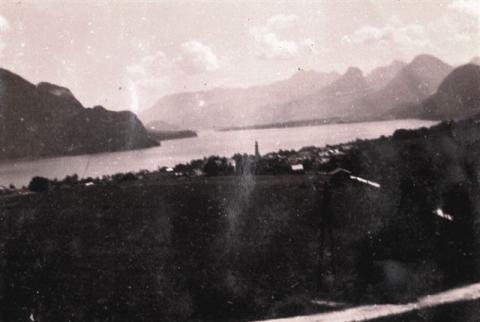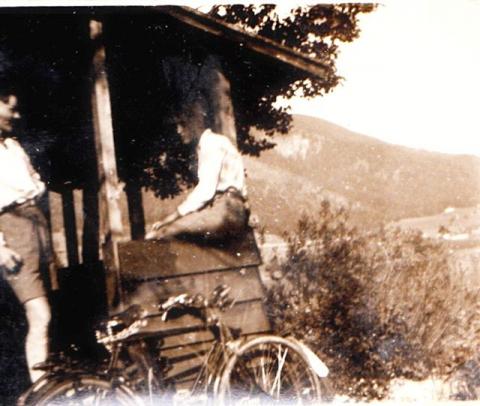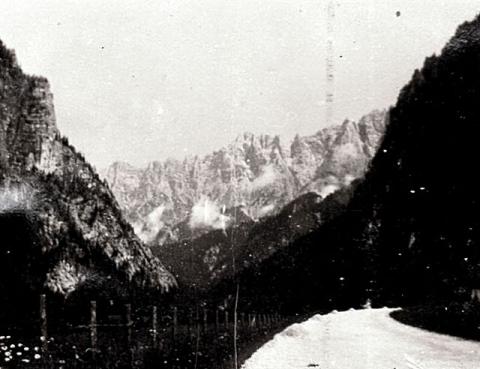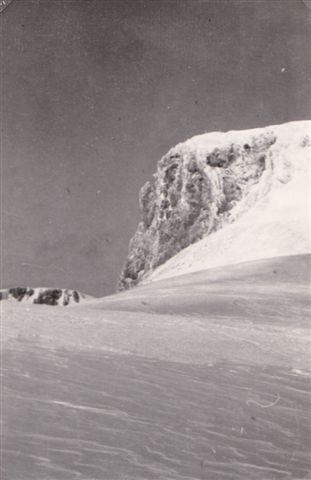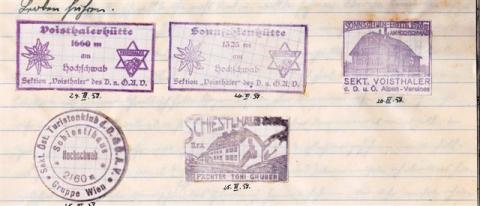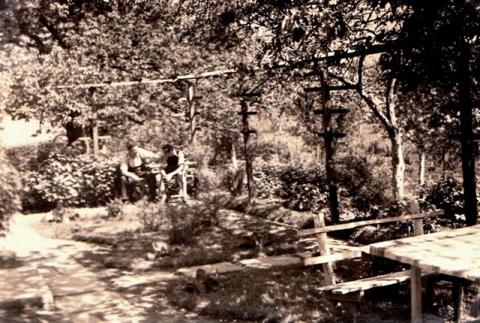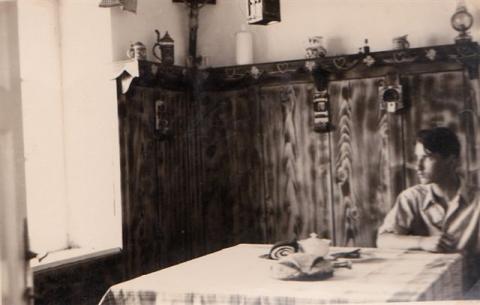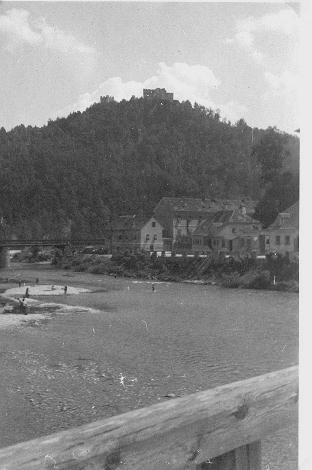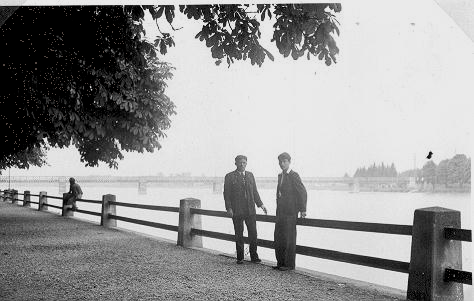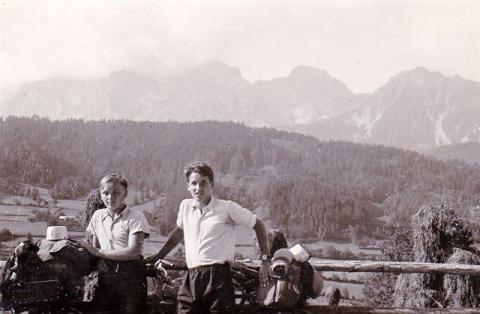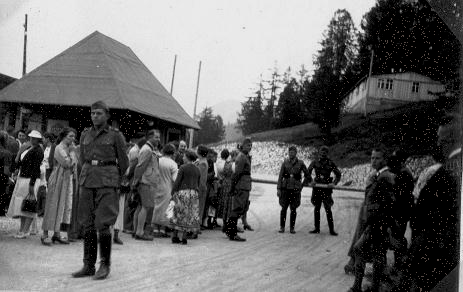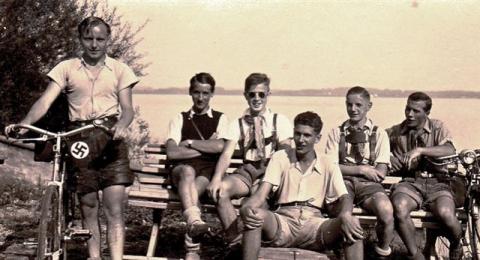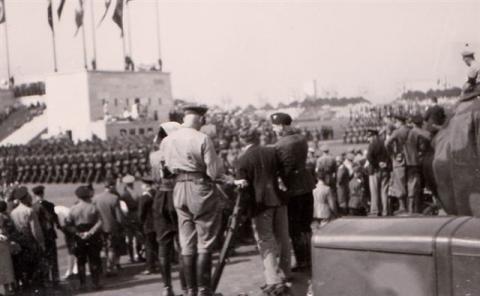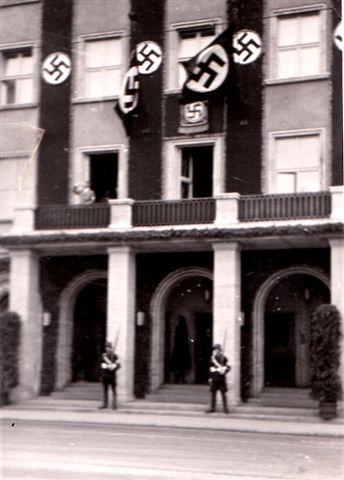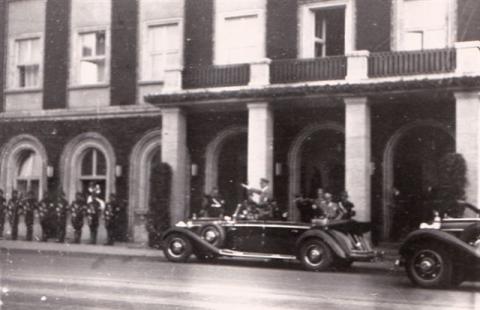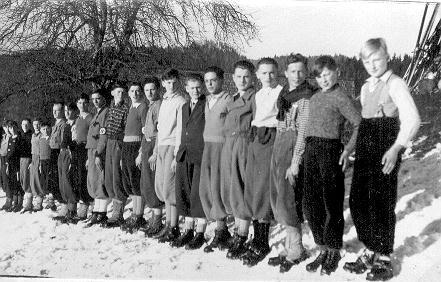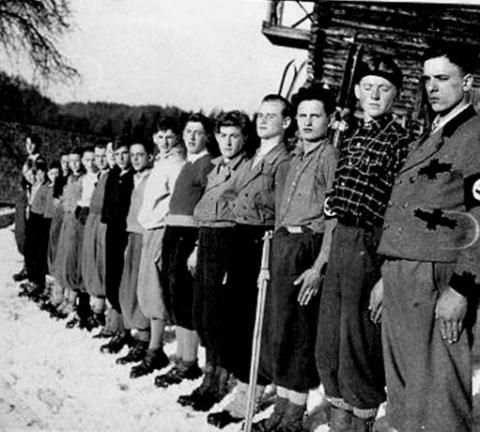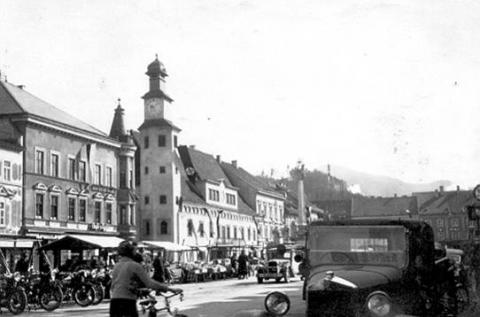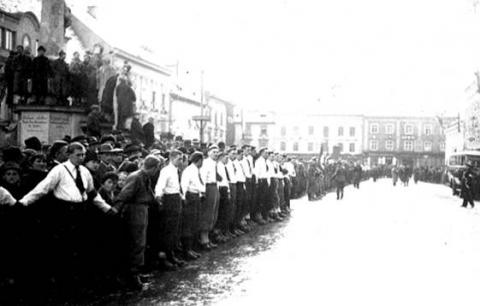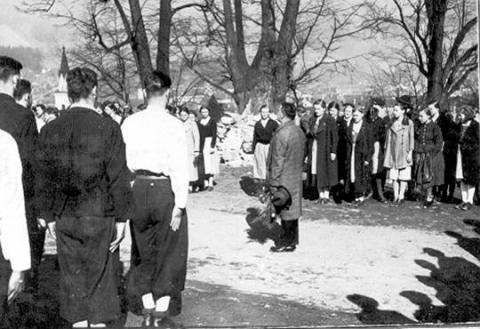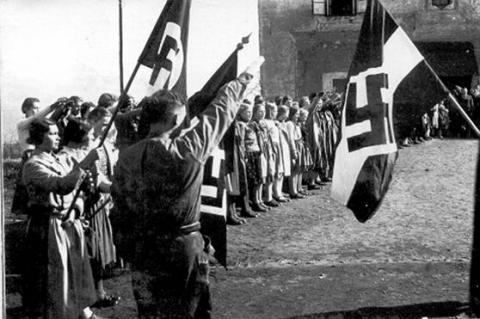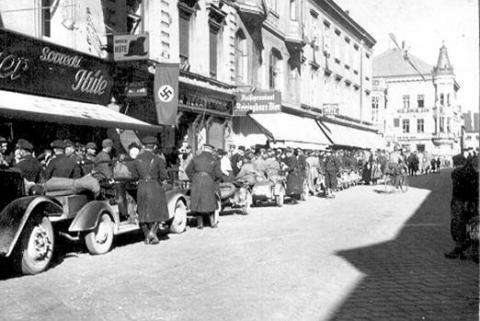Hitler Youth
- 2709 reads
Bicycle Adventures of an Austrian Teen
- 4888 reads
From Leopold Wenger's Trip Diary
Out and About on the Bicycle
1936-1937
copyright 2013 Wilhelm Wenger and Carolyn Yeager
Translated from the German by Wilfried Heink
Leopold Wenger was born on Nov. 19, 1921; in July 1936 when his first diary-recorded bike trip began, he was only 14 years old. By the time of the rest of the trips recorded here (all of which took place before the annexation of Austria to Germany), he was 15 years old. Quite a responsible, resiliant, hardy and adventurous young National-Socialist "Hitler Youth" he was, who later became a valiant defender of the Reich. My thanks to Willy Wenger for sending these diary entries to me – along with the photographs taken by 'Poldi (called Bibi by family) – and to Wilfried Heink for translating it from the German original – a large undertaking.
While this may not interest everyone, I believe it is of great value for comparing our youth of that time with our youth of today. -cy
P.S. On 6-5-2016 I linked the images to the file view, so just click on them for a larger view.
The Salzburg Journey, May 5-8, 1936
Sunday, July 5, 1936. We were to leave Leoben at 5:30, but I slept in and was picked up by Prommer and Horvat; we left Leoben at 5:45. We traveled via Edling to Seitz. Between Kammern and Mauten, we had to stop for the first time, my canteen/flask, fastened to my rucksack had slipped between the frame of my bike and the hind wheel during a descent. It acted as a brake, and the felt encasing was severely damaged.
The first rest stop was at the Schober summit. We arrived in Liezen at 12 noon in time for lunch. It had been extremely hot all morning. Past Steinach-Erdning we left the main road, pushed our bikes for one and a half hour over the Klachau pass and arrived in Bad Aussee at 16.45. We rested for awhile and at 17:00 we started to push our bikes to the Koppe, a very narrow pass used as a shortcut to Hallstadt. At about the border between Styria and Upper-Austria the road reaches its highest point, to the right a canyon used by the railroad. The road was in horrible shape; a car could never have driven through here. There were also warning signs posted: "Bicycle riders dismount, very steep grade, avalanche danger!"
At 18:00 we arrived at the Hallstätter Lake and started to look for a place to camp. We asked a farmer and he showed us a spot. We cooked tea on a camp stove and ate sardines and sausages (from Hovarth). At dusk, we prepared our bed site, watched some ships on the lake all lit up, and went to bed at 8 o'clock. We had encountered a strong head wind all day, the day had been warm, there were no mechanical defects worth mentioning.
Town of Saint Gilgen on Lake Wolfgang
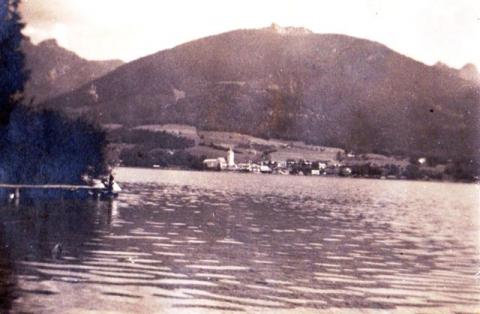
Saint Wolfgang on the Wolfgangsee
Monday, July 6, 1936: We woke up at 4:15, a short run took us to a well for washing. After preparing breakfast (lemonade), and cleaning of the site, we left at 6:30. The journey took us through Hallstadt, Goisern to reach Bad Ischl at 7:30, where we purchased camp stove fuel and bread. We did not stay long and at 8:15 we had our first glimpse of Saint Wolfgang Lake, but did not enter the town.
We camped across from the Inn “weissen Rössl” (The White Horse Inn, made famous in an operetta), went swimming and watched a great crested grebe for the longest time. At 12:00 we continued our journey to soon reach Saint Gilgen, atown with beaches, sailing as well as motor boats, steam ships, etc. Then we had to push our bikes again and, when we descended toward the Fuschl Lake, I lost Horvat’s jacket which had been fastened to my rucksack. At 3:00 we arrived at the lake and camped at the shore. Horvat and Prommer killed a snake, probably a grass snake which was just eating a fish. Some fishermen were fishing with nets.
We rented a boat and spent an hour on the lake, almost running into a woman’s head. She was wearing a big straw hat which we mistook for floating debris. We then again swam for a while, to later prepare supper (cocoa cooked with water and marmalade). We then tossed a few floating objects into the lake and aimed at them with rocks until it was too dark. At 9:00 we bedded down on the veranda of a nearby bathing hut, the floor was extremely hard but we were dead tired and slept well. The weather had been good again, just like on the previous day and no mechanical defects either.
Tuesday, July 7, 1936. At about 4:30 Prommer woke me, he and Horvat had been up for a while. I quickly washed in the lake and then cycled to a farmer for fresh water. We again cooked tea and left at 5:00. At first we had to push our bikes again, then downhill and up again. It was extremely hot and the sweat just poured from us, we of course had taken our shirts off a long time ago. We were very thirsty and drank a lot of water to help cool us down.
After pushing our bikes up the Gaisberg, we could see the city of Salzburg in the valley. A joyful descent started on twisting roads, passing a few cars to soon reach the bottom. At 9:00 we could see the Castle, we traveled through town, visited the house in which Mozart had been born, as well as the Cathedral. We then made a side trip to Hellbrunn to watch the trick fountains, view the Palace, the zoo, as well as the park of the Emperor. We then mailed a few picture postcards, and at 12:00 sharp we left Salzburg, following our three hour tour through the city.
 Right: View of Salzburg castle -enlarge
Right: View of Salzburg castle -enlarge
We stopped for lunch at the crest of the Gaisberg. We had just started going downhill when Prommer caught a rock in his rear wheel, it only took him fifteen minutes to fix it and we continued our journey. In Hof we turned north to reach Thalgau on a steep and bad road, to then reach Mondsee. A few kilometers on, the tire on my rear wheel suddenly went flat. I couldn’t find a nail in the tire; I therefore assumed that it was the valve, and exchanged it, but that wasn’t it. A thunderstorm came up, it started to rain but to our luck a farm was nearby. The farmer gave us permission to fix the bike in the barn, I finally found three holes in the tube and repaired it. The rain was coming down hard now, so all we could do is wait. It would have been a comfortable wait if not for the many flies.
By 6:30 the rain had stopped and we continued our journey, and we decided to make up for lost time by travelling at night. The road along the Mondsee was carved out of the rock; we often had to ride through tunnels, reaching See at 7:00. Then to Atter Lake and along its shores to Weißenbach, marveling at the size of the lake. After that through a forest to the Gmunden-Ischl road.
Right: We spent the night in a woodshed. enlarge
It was now getting dark, we needed to turn on our lights before we even reached Ischl. Horvath was in the lead, his light produced by a dynamo, then Prommer and me with our flashlights; we only turned them on when someone was on the road. It took awhile to go through Itschen, we got lost, but finally reached Goisern at 22:00hrs. We rested for a while, cooking cocoa. At 23:00 we continued and reached the foot of the road leading up to the Pötschen pass at 23:30. Here we found a wood shed, we entered, cleaned it up and bedded down, falling asleep almost immediately. The night travel had been strenuous. No wind during the day, the weather nice at first, then rain, and we also had some mechanical problems.
Wednesday, July 8, 1936. The Pötschen pass road was steep from the beginning. After a half hour pushing our bikes we were half way up and had breakfast in a restaurant, every one consuming a liter of milk. We had our first view of the Dachstein. When we reached the pass at 6:30 Horvat was stopped by a policeman; he had no stoplight. The road down to Aussee was in good shape, we made good time and arrived in Lietzen at noon. We were about to get off our bikes when Horvat was hit by another biker; the damage was slight.
We had our lunch in a restaurant, goulash from a can, sausage and bread, accompanied by apple cider, which made me tipsy. A thunderstorm with strong winds surprised us, we were sitting in the restaurant garden and had to seek shelter in the house. At 3:00 we could continue, the street was a mess, torn off branches as well as mud. We reached Hiflau at six in the evening, it had hailed. We arrived in Eisenerz at seven, tired, but we still had to make it up to the Pöbichl pass, a three-quarter of an hour climb we were told, wrongly.
We were half way up when a thunderstorm suddenly appeared; Horvath was behind but Prommer beside me. I yanked my jacket out, lost my hat and was drenched in minutes. We took shelter under some trees, and when the lightening stopped we looked for Horvath in pouring rain. He had found shelter in a wood shed, we changed clothing and decided to stay if the rain didn’t stop.
I just had taken off my wet shirt when we hear a motor vehicle approaching, my comrades jumped out to stop the van of a well known Leoben merchant. The driver agreed to take us, and we made it to Donawitz in reasonable comfort. Prommers landlord took him and our rucksacks, Horvart and I arrived back in Leoben at 20:30.
The weather had been lousy all day, delaying our journey, we also had a small mishap. I spent the most money, 6 shillings.
The kilometers traveled on each of the 4 days: Day 1, 36km; Day 2, 64km; Day 3, 132km; Day 4, 151km.
Rushing water and steep roads in the Gehäuse National Park, Styria
Präbichl-Polster, March 6-7, 1937
Saturday, March 6, 1937. I arrived home at 13:00, packed my bags, fastened my skis to the bike, Wurschitz was to pick me up at 14:00 but arrived late and we had to hurry to reach Präbichl before dark. At 16:25 we were in Vordernberg, snow was still on the road; my bike was defective so we shouldered our skis and started the climb up the Präbichl road. We were hungry and stopped to eat some buns. Not an easy climb, a strong wind blowing snow into our faces. We took a shortcut and reached the German and Austrian Alp Club youth lodge sooner than expected. A young man had already arrived, soon more came.
And we went to work, chopping firewood, building a fire to cook tea. More people arrived, 20 in all. We drank tea, sang songs, filled our bellies, to finally bed down at 23:00, covering ourselves with everything we could find.
Sunday March 7, 1937. I woke up at 7:00, the sun was shining through the window already.
After folding the blankets, we washed in an icy trough; the tea was delicious. We waxed our skis, each praising his wax. My shoes were still wet but I had no choice but to wear them.
The first boys who had taken the train started to arrive, and the first competition was to start before noon. The weather was nice, the snow conditions varied, with drifts. The downhill race was spread over two slopes, the first rather easy, the second steep. 5.3 min was the best time, 13 min the worst.
For lunch we had pea soup with sausages, then some of us rested while other engaged in a snowball fight. The sun was gone and in the afternoon a patrol exercise was planned: Downhill then cross country. Our group came in third. At four we were getting ready to leave, we skied down to Vordernberg, I fixed my bike and was home in little more than an hour.
Easter at the Hochschwab, March 24-27, 1937
Wednesday, March 24, 1937 Departure from Leoben at 7:30, when I arrived at the train station everyone was there already. We changed trains in Bruck an der Mur, then travelled to Au in a motor tram and all nine of us … marched to Seewiesen (7km). There we had a short break. We tried to purchase some bread but only found half a loaf.
Soon we were able to put on our skis, making things easier. We watched chamois (a goat-antelope species native to the mountains in Europe), some close by. It was overcast, snowing, the mountains in fog. We had lunch at the Forschel-Alm, then on to the French Cross (the French had allegedly advanced to here). Then downhill, again many chamois, and suddenly the Voitstal hut appeared from the fog.
Following another short lunch break we made a trial run down the slope; Scherabon broke the tip of one of his skis. A storm came up and we returned to the hut, the wind blowing strongly up here. We met Prof. Müller, had supper, sang some songs and went to sleep. I took a peek outside, it was very stormy, some men trying to reach Schiestl house had to turn back. We could hear the wind howl all night long.
Thursday, March 25, 1937. We had hoped that the storm would subside, but we were wrong. Right after breakfast we started our climb, the wind becoming stronger as we climbed. We experienced some equipment problems and if it would not have been for the long poles, placed along the way, we surely would have gotten lost.
We were covered in ice. I tried to drink from my canteen; I had filled it with hot tea but it was frozen. Shortly before reaching the high plateau, we almost missed a crack, but Prof. Porsche changed course just in time. At the plateau, the wind had reached hurricane strength, we had to stop repeatedly but I was blown over a few times just the same. Our faces were numb and at noon we reached the Schiestl-House (2,160m).
We spent the rest of the day playing cards; toward evening the storm subsided, the fog lifted and we ran to the Hochschwab-Western-Wall (400m high). After supper we bedded down.
Friday, March 26, 1937. The storm had subsided, and after breakfast we continued our climb. We had to climb some 117m, without skis, the snow was too icy. Finally some sun; an icy wind was blowing at the summit, freezing the ink in Prof. Porsche’s pen while he was trying to enter our names into the summit register. We walked down the icy southern slope, we were only able to put on our skis half-way down. We passed many signs with the inscription: “Frozen to death during a snowstorm.”
The snow conditions improved, we fell more than walked down a steep embankment and reached the Sackwiesen-Alm at noon. Fog had come up during the morning, but the high marking posts guided us. Now the sun was shining, the view was great.
Uhrmann and I dug a hole in the snow, found some brush, laid down and baked in the sun. But clouds came up and we continued our march, and at 16:00 we reached the Sunshine-Hut. After something to eat we decided to climb up to the Ebenstein (photo right), fearing that the weather would turn bad. Three remained behind, I continued of course, had some problems with my skis, took them off but caught up with the others again. Soon the others had to take their skis off also and we left them further up the slope, having secured them first.
The last part we did using our poles for support, not an easy task, the rocks were loose and covered in ice. An icy wind was blowing at the summit; we noticed a cross, a man had committed suicide here. All of us signed in at the summit registry, no one had been up here for weeks.
We met two people from Leoben - Dermutz and Domschütz - at the spot where we had left our skis; they suggested a wager, boasting to reach the hut before us, even though they still had to make it up to the summit. We waited until we could see them returning, and then left, skiing carefully at first but later on straight down. I lost control and crashed, the worst fall ever. Luckily I had given my camera to Prof. Porsche, or it would have been destroyed.
I caught up to the others again and made it down without further problems, and we did beat Dermutz and Domschütz who arrived shortly after us. We spent the rest of the day and evening in our rooms, only going out before bedtime to see a beautiful full moon.
Saturday, March 27, 1937. It was snowing, but we nevertheless decided to climb the little Ebenstein. We had to turn back however; it was snowing too much. About 10:00 we left for the valley. We had fun skiing down, all of it seemingly more dangerous than it was. We arrived in Tragös, had lunch at the green lake, with Prof. Porsche cooking tea. We then climbed via the Hiesl-Corner to the Rötz-Trench, a seemingly endless route. We just made the train in Trofaich.
The stamps of various Alpine-Clubs as collected by Bibi
The Pentecost Journey, May 15-18, 1937
Saturday, May 15, 1937. The morning was extremely hot already and since there was no school I went for a walk in the forest, returning at 12 noon. After lunch I packed my bag, fastened it onto the bike but discovered that the rear wheel was flat, a nail protruding through the tire. I fixed the flat and left Leoben in the direction of Graz. I had forgotten my map but did not return, arriving in Graz at 5:30pm. I had to push my bike up to Ries, then downhill to Gleisdorf and a little later I had to turn my lights on. I almost fell asleep and was hungry, so I decided on a short break, did some pushups and after a few buns and water I continued my journey. Again on foot up the Dachsberg, passing the big slide, then quickly through Klausen. The last stretch was slow going, gravel road and my tire was worn, the air almost gone out of the tube. I arrived home at 8:30pm; my Dad, who had arrived by train an hour earlier, was waiting for me.
Pentecost Sunday, May 16, 1937. I woke up late, I was still tired and since I had no plans for the day I helped Dad, resting in the afternoon.
With Dad in the garden
Bibi in the kitchen.
Pentecost Monday, May 17, 1937. I had to go to town hall in the morning, and on the way back my tire went flat in a few seconds; I had a hard time stopping. Because of the tire being worn, the tube stuck out on places, and a big hole was the result. I had no patches along, but found a used tube in a store and was able to continue. At 2pm, after lunch, I started for Graz and made good time but near Gleisdorf my tire went flat again. I exchanged the valve, that didn’t help and I finally noticed that the patch I had applied in the morning had come loose. After an hour I could continue, reaching Graz at 6pm, staying over night at Grandma's. My arms were sunburned and hurting.
Tuesday, May 18, 1937. At 6am, after breakfast, I left for Pack (a municipality in the district of Voitsberg -cy). It took awhile to find the right road. I liked the road from Graz to Tobel and the latter a nice place, a spa town. I purchased a few rye flour buns at Voitsberg and later rested a little. I got lost again at Köflach because I had no map and had to return. From here on I had to push the bike often, took what I believed to be a shortcut through a forest, a mistake as it turned out. It was extremely hot and the last stretch to Pack took one and a half hours, pushing my bike. At 11am I passed the big silver cross and a little later the border to Carinthia. I had to stay on the right side of the road now, but decided not to take the Pack road, as I would have had to backtrack.


Left: Resting at The Pack. Right: A look back at the Styria side of The Pack.
The Pack road looking at it from the Carinthia side.
I took a break right at the border and then continued downhill, not used to traveling on the right side but I managed. The road was good and I reached Twimberg at 12 noon, but now the road deteriorated; it was also going uphill again. It was market day in St. Leonard and I passed Reichenfels. I again passed the border into Styria at 1:45pm. Soon after I had to climb the last hill, but the ride to Judenburg was great; I never had to peddle. Just outside of Knittelfeld, I ate my last bread; I had never been in this region.
The ride to Leoben went well, arriving just before 5pm. My front wheel came loose just before home, but I did make it. This was the only problem all day with the bike.
Daily mileage: Day 1, 130km; Day 3, 60km; Day 4, 166km
Summer holidays 1937
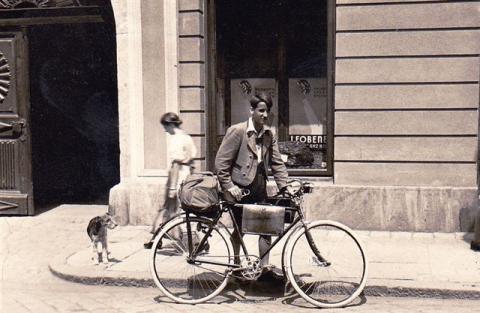
Monday, July 5, 1937. Mom, Willy and Gretl had already left when I readied my bike - the touring club banner on the handle bar, my backpack on the rack and a bag fastened to the frame, I must have looked quite adventurous. I left at 11am, Dad took a picture, stopped for a short time in Mühltal to chat with some boys I knew, and then away in a hurry. Dad passed me on his motorbike, waving, and at quarter to twelve I was in Pernegg, to stay with uncle Fritz. When I leaned my bike on the wall, I heard a loud hissing noise, the air leaving my rear tire.
Right after lunch I started to fix my bike, admiring the new tires Dad had bought, but then I found a large cut in the tube, the tire itself however was not damaged. I have no idea how this could have happened. At 4pm I was finished, too late to go swimming but, in spite of it all, I felt lucky that this happened at my uncle's place and not along the road somewhere.
Tuesday, July 6, 1937. I got up at 6am and left at 6:45, packing some potatoes and other goods for Grandma in Graz, received from aunt Leni. At a quarter to 9:00 I arrived in Graz to meet Mom and both of us went to the consulate. At 2pm Mom, Gretl and Willy left; I toured through Graz in the evening, viewing it by light. But my tire went flat again; someone might, while I was in the consulate, have pushed a pin into it.
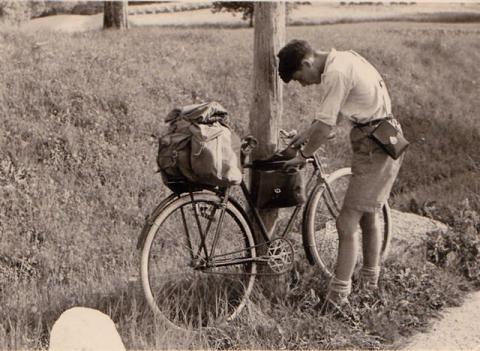
Getting ready for the downhill ride, after pushing the bike up the Riesenhöhe in eastern Styria.
Wednesday, July 7, 1937. I again got up at 6am to leave at 6:45, getting up the Ries was hard, but once on top I had fun. I rested for a while to travel to Gleisdorf; from there on the road was in bad shape (repair work). At a quarter to ten I arrived in Feldbach, from there over the Dachsberg to Gleichenberg, and at 10:15 I arrived at our house. It looked terrible, the grass high, no flowers to be seen, the floor coverings in the house moldy, the place had not been aired out since Pentecost. I borrowed a sickle from Great-Grandma, as well as some other garden tools, and went to work.
After lunch I continued, worked ‘till five, only then did the place look presentable again. At seven it started to rain, a thunderstorm, it did not last long. The day had been hot, but now I’ll quit, I need to study the maps yet, good night!
Thursday, July 8, 1937. Another thunderstorm at night, I woke up past six, cooked some cocoa, and after things were cleaned up, the key returned to Great-Grandma, it was 7:30.
Right: Leaving our Gleichenberg home after cleaning up.
-----------------------------
I left towards Straden, but circled around the town to not have to push my bike, the road to Mureck was in bad shape. From here the road was paved, I marveled at the arrangement of the farms, their cleanliness. When Straß came into view, the road branched off to Spielfeld. I had travelled along the border from Mureck to Spielfeld. A remarkable scenery on this side of the Mur in Austria - flat land with the occasional small forest. On the other side, in Yugoslavia, hill country. The Mur disappointed me, I had imagined it wider.
Then the border. First the Austrian customs - I had to hand my pass, as well as my trip itinerary over; I received a bike permit, along with other formalities and only then was I allowed to proceed to the Yugoslav side. The customs officer, an older man, spoke Slovenian but when I answered in German he also switched. In the station my pass was stamped, my itinerary checked, the baggage checked and that was it.
I was now allowed to travel on, but had to ride on the right side of the road, very confusing for me. The roads were bad; just before Marburg I had to climb the Leiterberg and then downhill. At the Marburg train station someone called out to me; it was Willy. He had waited for some time for me to arrive, to take me to Aunt Hilde’s new flat; I would never have found it. At five past ten I was home, only then I noticed that I had lost my flask.
No mechanical defects on the bike, all went well. In the evening we went to the movies, returning around one.

Willy and me, the Styria hills in the background.
July 9 and 10, 1937. Raining mostly, we stayed home.
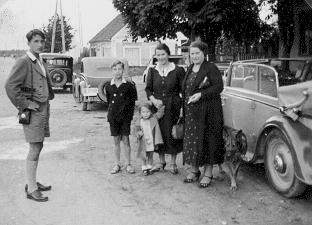
In St. Nikolai with siblings, mother and aunt.
Sunday July 12, 1937. Before noon the weather was not good, but improved later. Uncle Emil had rented a car and we travelled to St. Nikolai for lunch.
13th and 14th, 1937. Nothing special.
Thursday, July 15, 1937. At 2:30 I left our aunt's place, with no real purpose in mind, at first traveling along the same road as with the taxi a few days ago. The road was straight but in terrible shape, full of potholes. I passed through some small villages, the houses built of clay with straw roofs, poor peoples' places. At 3:00, I arrived in Pettau, the castle and church visible for a while already. The roads in town were paved with cobblestones, very rough going. I passed by the church with the free standing tower, allegedly built by the Romans - a watchtower with figurines carved in, some thousand years old. I left at 3:30 and arrived back in Marburg at 4:30.
Friday, July 16, 1837. I left again at 1:30, this time toward Windisch-Feistritz. I left the main road In Hoce, peddled and pushed up a hill, to then turn back to enjoy the downhill journey. Down below I could see Marburg. I then turned toward Windisch-Feistritz and had to push my bike up two hills before reaching the village. I had lunch in a restaurant, returning the same way I had come, arriving back at 5:30.
* * *
Thursday, July 29, 1937. I again travelled to Windisch-Feistritz, but turned off before I reached it to make my way toward Pragersdorf. I had to wait for a train to pass, and when I started out again I realized that I had taken the wrong turn, but I finally reached Cirknice. Leaving the village I entered the flat Pettau field and could vaguely see the Boc and Donati mountains in Croatia. I had to cross the rail line Pragersdorf-Pettau several times to finally make it back onto the main road. A nice ride to Pettau, forests on both sides of the road. Going through Pettau to look for the road to Warasdin, I had to stop to tighten a nut on my pedal, only to later turn around. Going back on the same road I had taken on July 15, I returned to Marburg.
Right: The Drau River near Cilli
With Dad on the shores of the Drau near Pettau
Thursday, August 5, 1937. I left Marburg at 9:30 on the road to Windisch-Feistritz again, then towards Ganobitz. I caught something in my eye, unable to remove it I was able to only see with the other. I witnessed a cavalry maneuver by the Yugoslav forces, then over two hills. The road went almost straight up, making it hard to climb, and downhill one had to be extremely careful. I made it to Gonobitz and after I had passed it, uphill again. I rode at first, but it was too hot, so I dismounted and pushed the bike. I rested under a tree and after reaching the crest it was steady downhill, passing many sawmills. At 1:00 I was still 9km from Cilli, but made it in half an hour. I crossed the Sann river, it looked like a bathtub, full of people. I noticed the ruins of the Cilli castle, then passed the Hotel Union, a beautiful structure, formerly the “Deutsches Haus”. I spent half an hour, then started the return trip. Half way up the hill it started to rain, but I just kept on going and was soon out of it. A short rest in Gonobitz, then to Marburg, home at 6:00.
Sunday, August 8, 1937. At 6:15 I left Marburg, this time with all my luggage, the Turner lake in Carinthia the destination. It was cold, I travelled the Rau upwards, passed castle Wildhaus to Zellnitz. Then along the Drau, uphill, downhill, I stopped for a rest before reaching Mahrenburg, then to Drauburg. Here I left the main road in the direction of Prävali, the dust on the road was inches deep. At noon I reached Prävali, but did not stay there but travelled on to pass the Petzen for the second time.
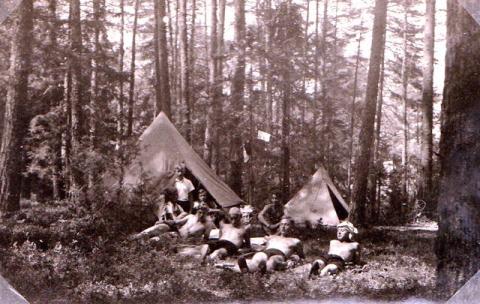
Illegal Hitler Youth camp at the Faaker Lake in Carinthia.
Past Prävali I had to push my bike up a hill and suddenly I was at the border, but the inspection was very relaxed, I did not even have to open my rucksack. Then through Unter-Loibach, past Blechburg and St. Stefan to Eberndorf. I noticed that all signs were in two languages, German and Slovenia, in the middle of German territory!!! I had to search for the Turner Lake, but found it, the shores all swampy and in the background the Karavanks, breathtaking.
Saturday, August 14, 1937. I stayed for almost a week in this beautiful region and met a few young men I knew. One of them joined me on my way back to Leoben. We left at 6:00, passed the Klopeiner lake on a lousy road to Kuhnsdorf. The road conditions improved and after a short climb downhill to the Drau, quite narrow already.
Past the bridge we had to push our bikes uphill, to Völkermarkt, reaching it at 7:45. We viewed the war memorial, then to Griffen, the ruins of a castle glued to the mountain side, visible from the distance. Past Griffen, up a steep, seemingly endless hill, and it was very hot, then carefully downhill to Tabakfastl and uphill again. A truck passed us slowly, we latched on to it and reached the crest with relative ease. Downhill again to St. Andrä, passing through at 10:00.
Now our stomachs started to growl, we had nothing to eat since 6:00, aside from a few apples. We planned to do some shopping at Wolfsberg, marveling at the castle from afar. Through a park-like setting, we entered the city at 11:00. We purchased some bread and marmalade, peddled on for a while to then stop for lunch. We just layed in the grass and ate, the water in our canteens was unfortunately too warm to drink. We moved on at 12:30, the Lava valley very narrow - river, train tracks and road close together. A steady rise and, because of the heat, my head started to hurt. We made it to Twimberg and now the road to Leoben was familiar to me. In St. Leonhard we stopped in an Inn to cool down a little, then to Reischenfels (809m), up to the Obdacher saddle (945m), pushing the bikes. At the summit we rested for a while, then down to Obdach, a short rest at the fountain, then to Zeltweg, the tailwind helped. Finally a paved road again and we made good time to Leoben, arriving at 5:15, and I was glad to be home again.
Tuesday, August 17, 1937. It had rained for a few days, but now I started out again, at 11:00am, in the direction of Graz. I could not have left any sooner; my bike was being repaired. I carried hardly any luggage and reached Bruck after 25min. A small repair on my bike delayed the journey some but the tailwind helped and I arrived in Graz at 2:00pm.
Wednesday, August 18, 1937. I left at 1:00pm, pushing the bike up the Ries again ... A shower while going downhill, the road from Gleisdorf to Studenzen under construction in places. At 4:00 I arrived at our house, the place looked desolate again, but not as bad as on my last visit. I started to tidy things up and at 7:00 Mom arrived, as well as aunt Hilde, Willy and Greterl.
Friday, August 20, 1937. I left at 3:00pm for a little tour. Past some road construction near Straden, then pushing uphill again, sweating. At the top I looked for the road to Mureck, downhill with a view of Straden, then through a beautiful forest. I chased up some grouse, magpies and stellar jays along the road to Gleichenberg.
* * *
Thursday, August 26, 1937. I left Gleichenberg at 8:45, it was cool after a week of rain. The road looked the part, but I made good time and drove through Feldbach at 9:30, to arrive in Gleichendorf at 11:00. Paved road again, but one of the pedals broke off, forcing me to return to Gleisdorf to have it repaired. A half hour later I was mobile again and reached the summit of the Ries in one hour. From up here, I could see a rain shower hit Graz, I waited a while before going downhill, but the road was still wet when I left. The rain had stopped and I arrived in Graz at 1:00.
Friday, August 27, 1937. I left Graz at 8:15 this time, encountering a strong headwind right from the start, making travel difficult and aside from that the gearing in my bike was loose again. At 9:15 in Peggau, a half hour later in Frohnleichen, doing a steady 20kmph. A motorized army unit came towards me, at 10:30 I arrived in Pernegg and after a short visit with uncle Fritz I moved on. The headwind was still strong, at 11:00 I traveled through Bruck and 50 min later I arrived back home in Leoben.
Continue to Part Two: "The Great Ride to Nürnberg" for the 1937 Reich Party Convention
Tags
Leopold Wenger, Hitler Youth, bike tripsCategory
Austria, Leopold Wenger, National SocialismBicycle Adventures of an Austrian Teen - Part Two
- 4393 reads
From Leopold Wenger's Trip Diary
The Great Ride to Nuremberg
for the N-S Party Convention of 1937
copyright 2013 Wilhelm Wenger and Carolyn Yeager
Translated from the German by Wilfried Heink
Day one - passing the Dachstein mountains on the way to Schladming.
Sunday, August 29, 1937. My buddy Franz and I left Leoben at 6am. When passing the train station I suddenly discovered that I had left my canteen, full of tea, at home. I had no choice but to turn back.
We then continued. It was still cold, and also foggy; our clothes were soon damp. But the fog lifted and at Mauten we stopped for breakfast. Then a headwind picked up, making travel up the Schober Pass difficult. At the top we stopped at a farm to drink some milk; Franz encountered a little mishap but at 11:30 we arrived in Trieben. We did not stop, passed the Wörschach airport and at noon we were already passed Steinach. We rode through an open forest; later in open country with the sun beating down and stopped at an Inn in Diemlern for lunch. The ride from then on was boring, up to Gröbming when I noticed that the houses were different, almost flat roofs with boulders on them. We had climbed quite a ways up and now traveled downhill, the road condition changing. Passing Haus, we had our first glimpse of the Dachstein, with the peak hidden in clouds. At 4pm we arrived in Schladming; the town was celebrating the completion of a new church tower and we had problems getting through the crowds. Uphill from there, and at 4:30 we passed the border between Styria and Salzburg. We already had the Mandling pass behind us.
In half an hour we made it to Radstatt, having to push our bikes up a hill along the way. We looked for the hostel, found it outside the town and registered at 5:30. The pool was a welcome addition and in the evening a youth from Vienna joined us.
Monday, August 30, 1937. It took ‘till 9:30 for us to get our things together so we could finally leave. Downhill to Kreuzberg, then onto the road to Bischofshofen. The wind was from the side, better than headwind, and on towards Salzach. The Werfen castle could be seen from a distance. It then started to rain but soon stopped again. Passing the Luegg train station we noticed that the road was closed.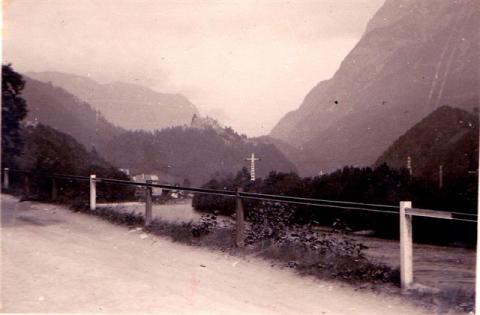
Salzach with the Werfen Castle
Tuesday, August 31, 1937. We met a Sudeten German in the morning, and since he was also heading for Nürnberg, we decided to travel together. We left early, Franz staying behind but planning to catch up. Thus I continued with Wilhelm Bechmit, whom we called “Charles with the Ark of the Covenant,” because his luggage was contained in a crate. We soon reached the Austria-German border, and after some formalities were allowed to move on.
 Right: The road to Reichenhall
Right: The road to Reichenhall
----------------
The international territory stretched on, the road following the border, but finally we entered Germany! At the customs we received receipts for our money and were allowed to travel on, no other formalities. We entered Bad Reichenhall and continued to follow the river Salzach, later resting beneath a colossal aerial cableway. Moving on, we passed two Hitler Youths and asked them if they are also on their way to Berchtesgaden. They laughed and told us that we were going in the wrong direction. We had no other choice but to turn back to Bad Reichenhall. Finding the correct road we continued, uphill, and along the border we could see an SS border guard. We had to dismount, it was hot and at the Hallthun train station we had reached the top. From here we could see the Watzmann and knew we were getting close.
At the Obersalzberg
Directions to the hostel were posted along the way; it was located outside the village - a brand new “Adolf Hitler Hostel”, the best I have ever seen. We registered and, since it was noon, ordered lunch. We sat on the terrace, amidst a group of people from all over: One from Hamburg, from Bavaria, two Americans, my Sudeten German friend and I, the Austrian, four nations together. After a lunch of potato pancakes and cabbage, we stayed together and called ourselves the International Club. In the afternoon, we climbed the Salzberg with the Bavarian in the lead, a 1000m climb, which took us an hour. Up there, I saw minister Hermann Göring by chance and on the way back a rain shower surprised us. We ran to the train station and since a train was about ready to leave we purchased tickets (15 Pf.) and rode to the hostel--the International Club returning to base. Franz had arrived. We spent the evening playing games, also singing. The Hitler Youth Radio Chorus stayed here also.
Wednesday, September 1, 1937. It had rained the evening before but now it was nice. After a short breakfast, we were getting ready to leave but when we picked up our bikes we discovered that a bunch of others were also traveling our way, so we all rode together. We said good by to the International Cub, then back to Bad Reichenhall. We bought groceries, which would last until we reached Munich and then continued in the direction of Teisendorf.
Traveling group assembled at the Chiemsee
Along the road we noticed a number of large Reich labor service camps, housing the men needed to build the Autobahn. We stopped at a larger farm and all seven of us received some buttermilk and bread, free of charge. We then passed through a tunnel, the Autobahn above us, to later view the straight line of this gigantic Autobahn as we climbed. We reached Traunstein at noon and were very hungry. We again rode to a farm, six of us now (one had left) and purchased a big jug full of milk. We continued, almost bursting, but still raided a few fruit trees, the ripe fruit begging. Then the Chiemsee. We rode along its shores to Seebrück, but unfortunately signs were posted all along: “No Swimming.” We continued and were able to go swimming when we were outside the village.
The water was cold but we swam to a structure erected by army engineers. We climbed up and chatted with a guard, with the island and castle Herren-Chiemsee in the background. We then swam back and it didn’t take us long to get to Hamhof, where we left the road and found a nice hostel. We placed luggage on our beds to show that they were occupied and then returned to the village to spend some time at an Inn, bowling. We returned at 8:30 and were read the riot act by the hostel Mom, who had become famous as we later found out. A few more songs and to bed.
Thursday, September 2, 1937. Next morning we rose early and left without breakfast, the packing of the bikes by now routine. But soon we again stopped at a farm to purchase bread and milk. We crossed the river Inn at Rosenheim; the town was festively decked out - some exhibition. We then passed an air force base, stopping to watch planes taking off and land, then continued raiding fruit trees again and at noon we were 27km from Munich.
We were hungry and one of us, from Augsburg, told us that there is a monastery close by, he had stayed in it, and surely we would get something to eat there, free. Around 1pm we arrived, but were told that nothing to eat is left over but to wait, something will be prepared. Fifteen minutes later two nuns appeared, carrying cutlery and a large pot of soup. We ate with relish and believed that this would be it, but no, we were then served meat, vegetables and salad. This really surprised us; we ate what we could but could not manage it all. A big jug of fruit juice finished the meal. We were stuffed, unable to continue our journey.
Served lunch at a Bavarian monastery
Franz lay in the grass, moaning. We were then allowed to view the beautiful rooms and finally continued, late. Heavy going at first, but we were nearing Munich and 15km outside the city the bicycle path started. We again passed an airport, a plane flying overhead, got lost but finally reached Munich. We passed the Maximilianeum, an imposing structure, then across the river Isar, bypassing the Church of my Lady and city hall to the train station. We were given directions to the hostel and arrived at 5pm. A little tour through town, then to bed at 9pm.
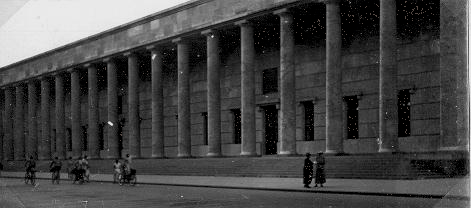
Above: The House of German Art in Munich; below, Victory Gate

Friday, September 3, 1937. No bicycling on this day; we tried to take in as many of the places of interest as possible in a short time: The Temple of Honor (Ehrentemple), The Brown House, The Hall of Heroes (Heldenhalle), the War Memorial (Kriegerdenkmal), Victory Gate (Siegestor), the exhibition of “deranged art,” the English Garden (Englischer Garten) and the House of German Art (Haus der deutschen Kunst). We went to bed in the evening dead tired.

The Temple of Honor (Ehrentemple), Munich

The Eternal Guard (Die Erwige Wache)
Saturday, September 4, 1937. The nicest wake-up call in all of the hostels: At six, the warden of the hostel played his flute, then called out “Get up, comrades.” The last to rise had to sweep the whole place. I slept on the fourth floor. It was 8 am by the time breakfast was over and we were packed; time to say goodbye for Franz and me. Our comrades, the lad from Augsburg, the one from Magdeburg as well as the Sudeten German “Charles with the Ark of the Covenant” (also called minister of finance, as he always managed to find something to eat for little money) planned on staying in Munich, but we had to travel on. As mentioned, we left at eight, and at the army barracks I had my only mechanical defect: a screw had come loose on the fender. The bicycle path was in great shape, we continued through a tunnel and a lad joined us. The road to Pfaffenhofen was almost straight and even. We saw troops, and just outside of Pfaffenhofen we entered hilly country and had to push our bikes at times.
Just outside of Ingolstadt it started to rain, but we continued and arrived in town at 3pm. The town gave the impression of a fortress, and rightly so—castle moats, bastions, walls with gun portals. We found a nice hostel near the Holy-Cross gateway, for now being the only occupants. After a late lunch we walked through town, first to the post office, finding my first letters from home. Market day at the town's square, people everywhere. At the hostel others had arrived, among them a youth from Westphalia, Heinz Borgmann. We visited the tourist information office to pick up some brochures, looked at churches inside and out, the Danube gate—the river still quite narrow here, and to bed at 9pm.
Sunday, September 5, 1937. It was already 8am before we rode off, four of us, and at 9am we were in the old Bishops residence, Eichstätt, having traveled at an average speed of 24kmh. The famous landmarks of this old town were everywhere; Willibald castle on one side, ruins on the other, the Monastery as well as many old Churches. Uphill from here on, not steep but impossible to ride. Markings in the stone showed how the river Altmühl had carved his bed, many holes in rock, with tunnels, easily viewed while pushing the bike. As we climbed, the view of the city, the castle and the monastery became more pronounced. No sun, therefore not too hot, and after a 200m climb we could ride again, but it was not a downhill ride but up and down all along. We rode through Weißenburg; we were in the center of the Franconian Jura. Up on a hill, then down again, not the most pleasant ride. We could now see banners strung over the roads and decorated with flags reading: “Welcome to Nürnberg.”
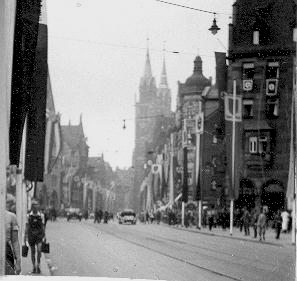
At 2pm we were in the city, saying good by to the others. We rode through town, old streets decorated with numerous flags (shown at right), past the Hotel ‘Deutscher Hof.’ Suddenly a loud roar from above, 450 heavy and light planes practiced the flyover, very impressive. We passed the Zeppelin meadow and ended up outside of Nürnberg, finding a place to stay in a farmer's hay barn because the city was filled to the brim. There we met two other boys, Rolf and Paul, who had also not found a place to stay in town and we made ourselves comfortable, planning on a lengthy stay. The farm was about 9km from town. In the evening, all four of us visited the Reich labor service camp and supper was served to us.
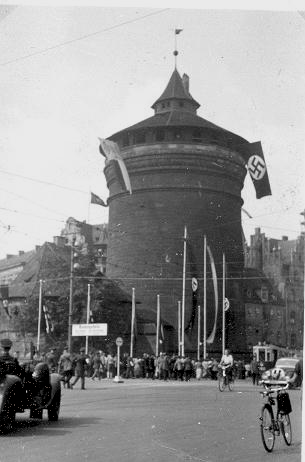
Right: One entrance to the Old Town (Die Altstadt) of Nuremberg.
------------------
Monday, September 6, 1937. We had slept well in the hay, got up at 7:30 and cooked our breakfast in the farmer's kitchen. After tidying up our place, we were ready to leave. On the street, we flagged down a car which took us into town, with one police check along the way. We were dropped off at Langwasser; we still had a long march ahead of us to reach our destination. [This is all that was recorded for this day. According to Willy Wenger, the boys surveyed the tent camp of the 38,000 RAD (Reich Labor Service) young men.]
Tuesday, September 7, 1937: We now decided on a day of rest, laying in the grass all day long soaking up the sun. In the evening we witnessed the practice for the light display, searchlights had been placed around the perimeter of the Zeppelin meadows.
Wednesday, September 8, 1937. Back to town in the morning, a truck driver gave us a ride. This was the Reich Labor Service day; from where we were we could see all the dignitaries of the Reich pass by in cars. A staff officer, who noticed us, gave us two tickets for the events; problem was, there were four of us, so we had to purchase two more. In the meantime, at 10:00, the columns of men were arriving, 38,000 of them marched past the Führer who was standing under the grandstand. We had climbed a light pole and could take it all in. When the parades were over we found a place in a stand at the Zeppelin meadows.
Now the shirtless young men from the Führer school marched onto the meadows – then the Führer spoke. The crowd erupted in cheers. The men from the Labor Service settled down on the meadows, their leaders passing out sweets and oranges, etc. Then the march through town. We, of course, got lost and only met up again in the evening at home—Paul and I not having eaten anything all day.
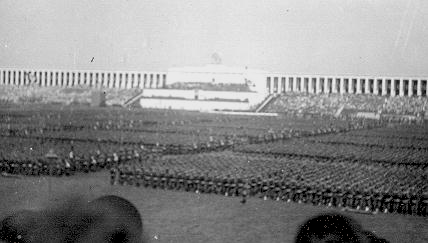
The Reich Labor Service assembled on the Zeppelin Field
Watching the RAD march on the Zeppelin meadow
Thursday, September 9, 1937. Today we left at noon for town, Franz and Rolf were to follow with something to eat. At 6:00pm we were to meet at the post office. There was a lot of commotion in town; huge masses of people were crowding the streets wearing uniforms not from Nürnberg. We walked passed the Deutscher Hof hotel, the place where the Führer was staying, the colors of the Führer flying in the breeze on the roof. The Führer was home. Impossible to imagine the crowds around the hotel; I almost lost Paul. One just had to go where the crowd did, no turning left or right freely; all were waiting for the Führer to appear.
Right: Hitler appears on balcony.
----------------------
I was extremely lucky that after only 10 minutes one of the balcony doors opened and the Führer stepped out to greet the crowd. The four thousand or so present broke out in cheers, the hail shouts not ending even after the Führer had left. When the crowds dispersed I was able to make my way right up to the barrier that was cordoning off the wide walkway between the hotel and the street. I had to wait for quite some time—political dignitaries passed by at times, the two SS honor guards saluting smartly. The SS guards were relieved every hour, an impressive ritual, the two of them marching by in cadence.
At 3:00, the Führer appeared again on the balcony, a repetition of the first, with again loud cheers from the crowd. We heard that the Führer was to leave at 4 o’clock for the Congress Hall; all waited with anticipation.

Dr. Joseph Goebbels leaves the hotel for the Congress Hall at the rally grounds
An additional honor guard was deployed—12 men, two officers as well as a drummer. Several leaders of the Party (Goebbels, Baldur von Schirach, Heß, and others) left in their cars, greeted fanatically by the crowd when they appeared. Then a motorcycle with a side car, a big yellow flag attached to it, left and we all knew that the Führer would come out in ten minutes. Everyone was tense; close to me a lady from Vienna fainted, SS men had to carry her away.
Hitler leaving the hotel with honor guard and drummer standing at left
A drum beat, the guards saluted and the Führer stepped out, greeting the crowds while stepping into his car, the right arm stretched out in the German salute. The car left slowly, and while the crowds had cheered when the other dignitaries were leaving, there was no comparison to the noise now. For a long time one could hear the shouts from people along the way as the car was passing. Only now was I able to get away from the crowd, and since I had two hours to kill before our rendezvous, I went for a walk in the old part of town. I had seen the castle from afar, apparently closed because of the crowds, and at 6pm precisely Paul and I were at the post office, but no sign of the other two. We were ravished and decided to leave for home, but it was hard to make any headway; the crowds already gathering for this evening's torch parade honoring the political leaders. Only later were we able to flag a car down to take us to our quarters. No sign of Franz or Rolf here either; they returned late. We found enough to eat in one of our old suitcases, turned into an “icebox.”
Friday, September 10, 1937. Getting up in the morning I didn’t feel well; but believed that it would pass. It didn’t. I was dizzy, weak, cold and not even hungry. Then we heard a loud noise from the road, we ran outside, saw a truck and about 50m away a car with its front grill stuck in a creek, but no one was injured. The car, doing 120kmh, had rammed the truck, jumped the ditch, drove onto a field, ran over a tree to finally come to a halt in the creek. Luck was with them, and with a joint effort of 10 SA men and us, the car was again put onto the road, a tire changed and it was able to drive off. I became ill from all the exertion and had to lay down. I had nothing to eat all day save for some unsweetened tea but in the evening I felt better.
Saturday, September 11, 1937: I was fit again, but it was raining and we decided to stay inside. In the afternoon Franz and I rode into town to visit Albrecht Appel, who a few days ago had returned from Palestine. (I had met him at Marburg/Drau for the first time). He had much to tell, had experienced a whole lot. At dusk, Franz and I rode back to Langwasser to watch the fireworks at the Dutzendteich lake; it was very late when we returned home.
Sunday, September 12, 1937. The day of my departure had arrived. I said good-by to Franz, Paul and Rolf, thanked the farmer for his hospitality, and at 7am I was on my bike on a foggy and cold morning. Not very pleasant, especially when traveling alone. At first, I wore my regular trousers, but changed into shorts later. The ride was not very nice, uphill, downhill, and on steep inclines the road was not paved, just sand and still wet from the day before. I got lost once; one car came toward me with minister president Hermann Göring the passenger.
In Neumarkt, a chap asked me where I was heading and then accompanied me. When I told him that I wanted to make it to Landshut, he replied that in no way would he go that far and this ‘super biker’ left me at Hemau. Near Oberwintzer I entered the Danube valley, traveled along the river and arrived in Regensburg at 1pm.
I passed the gorgeous Cathedral and stopped in an inn outside of town, and even though it was late, past 1pm, they served me a pork roast. I also ordered a liter of beer, not even asking the price. The hostess asked if she heard right, and that I wanted a liter. When she served it I knew why, but I managed to finish all of it, not wanting to chicken out. I still had 60km to go, not an easy task. I left the Inn at 2pm, a little unsteady, my feet heavy as lead. And to top it all, it started to rain, but I continued. I don’t remember much of this, but time just flew by. I was aware, however, that because of the fall maneuvers soldiers were billeted everywhere.
At 4:45 I arrived in Landhut, drenched, and I had to look for a long time to find a youth hostel. I then picked up a letter from home at the post office. Only four other guys shared the accommodations, and being dead tired I went to bed early.
Monday, September 13, 1937. After having made some enquiries I decided to take a different road than planned. I originally wanted to ride to Salzburg via Wasserburg but was told that the roads were bad, so I chose a different route and two chaps joined me.
It was 8am when I had my things together and I could leave, the other two had left already. The roads were very wet, it had rained all night, it was foggy and overcast. I soon caught up to the others, but the going was tough because of a head wind; it was also uphill/downhill again. It rained often. I had my raincoat at the ready, draped over the handlebar. We arrived at Vilsbiburg, a nice town where I purchased bread and butter. Finally the weather changed for the better. Metal windmills are everywhere in this area. The road leveled out and a tail wind helped. A thunderstorm came up behind us, the sky pitch black. We peddled like mad, crossed the river Inn just before Ötting and then the rain started. Now we parted company, the two going to Traunstein.
I was alone again, facing a strong headwind and on a gravel road. Noon had passed and I started to look for a restaurant. At about 1pm I stopped in a village but all I could get was a sausage and half an hour later I moved on. Just before Tittmoning, I reached the main, paved, road again. Far down I could see the river Salzach, the border between Austria and Germany. Then the river up to Laufen and from here I could see the Austrian mountains, already covered in snow. In the border town of Freilassing, I stopped to buy some chocolate and cookies and at 5pm I passed the border. This did not take long and I was soon on the way again. The Salzburg castle came into view and at 5:30 I arrived at the hostel I had stayed in two weeks prior. My clothes were drenched, as well as my shoes. Not as many guests this time and Salzburg was also not crowded, the festival being over.
Tuesday, September 14, 1937. I was ready to leave at 7am, but had to wait ‘till 8:30 before the host appeared to return my hostel passport. I was finally able to leave, it was cool and I wore sandals, my shoes still wet from the day before. I used shortcuts, pushing my bike up the Gaisberg and was then joined by a soldier from Salzburg. I had traveled this road a year ago and remembered it well. We advanced only slowly because of a headwind, the wind subsiding a little in the forest but only to then hit us again with a vengeance. Because of the conditions we did not get very far that day. At the Fuschl Lake, I re-discovered the bath hut I had stayed in before. Up a hill, then full speed down to the Wolfgang Lake - the first glimpse at the lake with Saint Gilgen was beautiful, the air clean. The bath huts were of course empty, the season over. Outside Strobl, we rested, raiding an apple tree with the consent of the farmer. My companion was a young, pleasant fellow. The head wind increased in velocity, we hardly moved but in Ischl it suddenly stopped. We now entered a new bicycle path, which followed the river to Traun. Past Goisern, we turned off to circumvent the Pötschen pass, I had bad memories about it from last year. At 1pm we bought some milk from a farmer, to then travel along the shores of the lake to Obertraun. I had also stayed there before. Then we had to push the bikes over a hill.
It took some effort to make it up the steep hill on a gravel road. But at 2:30 we arrived in Bad Aussee sooner than we would have going over the Pötschen pass. Then on the Mitterndorf, also not an easy task but from there we could see the Grimming, mostly covered in snow already. When we arrived in Klachau I took a deep, relieved, breath, then downhill, but steep; my companion dismounted. I stayed on the bike but had a few scary moments, and at the bottom of the hill had to wait some time for my companion to arrive. We now increased our tempo, because it was getting dark. In Wörschach the soldier left me and I continued, having to turn on my lights. Past Liezen it started to rain but I hurried on, hoping to catch a train in Selzthal.
I asked for directions and arrived at the station at 7pm, but then was told that the next train would not leave until 9pm. I used the time to catch up on what I had neglected: to eat. The rain now really came down and I was glad not to be on the bike anymore. It had also turned cold. The train left at 9pm, it rained continually. I tried to sleep but was not successful. I dozed a little and just before midnight I arrived in Leoben, my home town. In pouring rain I mounted my trustworthy bike for the last time and arrived home a few minutes later. My 1937 school holiday was coming to an end - a nice, if strenuous, time. Two more days and school would begin again.
A year later 'Poldi was in Nürnberg again, but this time as a legitimate Hitler Youth member. Shown here with friend Gilbert Giesendorfer at the Reichspartitag in 1938.
Category
Adolf Hitler, Austria, Germany, Leopold Wenger, National SocialismThe Days of Our Revolution
- 6493 reads
From Leopold Wenger's Trip Diary
The Days of Our Revolution
copyright 2013 Wilhelm Wenger and Carolyn Yeager
Translated from the German by Hasso Castrup
Following are the stirring events that took place in Leoben, Styria from February 12 through March 20, 1938, preparatory to the Anchluss (Austria becoming part of the German Reich) as recorded at the time by 16 year-old Hitler Youth member Leopold Wenger. Courtesy of Willy Wenger. -cy
12 February 1938 On our old campsite, at our cabin on Kraubatheck, there was for quite a long time already plans for a Hitler Youth camp again and it was scheduled to open this evening ... and as our term vacations were ending on 16 February, we were to spend four full days. Everything was already prepared and the food was already up there. I apologized that I could not come before Sunday because we had to sit in the police prison of Leoben and Wurschitz - 12 hours for a bicycle offense. (The fine was too expensive for us, therefore I had to endure the sentence). These 12 hours felt like an eternity. We were there together with all kinds of criminals: One of them told us that recently a Nazi was sitting there too, was then sent on to the district court but first he hid his revolver, cartridges and a swastika armband with the stamp of Donawitz in a wastebasket. One of the crooks found it and, with pleasure, handed it to the police.
Below: Our cabin in Schladnitzgraben; Right: Illegal Hitler Youth meet for skiing.
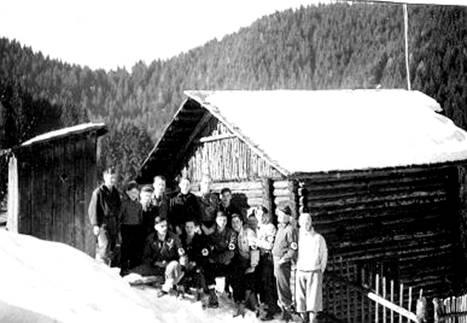
Group picture of Leoben illegal Hitler Youth, Feburary 1938
He asked me if I ever had anything to do with the police. Surprised, I denied it. Then he told me that our comrade Tiefental was brought to police HQ (hauled directly from his job) and interrogated by Major Zenz. He was shown a list, comprising all members of our [Hitler Youth] group in Leoben, including our group leader Marek. All the Scharführers, etc. were listed exactly. We were shocked. No one could imagine how the police got this information. That was the reason why the Hitler Youth camp had to be canceled immediately on account of the risk of a razzia [raid].13 February 1938: By chance we heard over the radio that Schuschnigg met with the Führer. We were very surprised by the humiliation, but did not get our hopes up because we did not want to be disappointed again. During the morning, some comrades were urgently looking for me. When I inquired in the afternoon what they wanted, I learned that I should have come to our hut.
14 February 1938: Early in the morning I took the train to Kaiserberg and went from there to our hut on Kraubatheck. My backpack was very heavy because it contained, besides the food, a brick. As we needed a new stove, everyone had to bring a brick. In the hut I found Ebner, Ebert, Klahr, Obermann and our camp cook. The day passed with skiing.
15 February 1938: I had apparently overeaten. I was not well, so I went home today. Earlier, Tiefental came by. He was sent from Leoben before midnight to fetch Ebner for a meeting with an associate of Scharführer, who had come from Graz. They came before dawn. Ebner with skis, but Tiefental still in his Sunday clothes; He looked great! I went home with the afternoon train. I was tired like a dog.
18 February 1938: At eight in the evening I had to go to a Führer roll call in Guenther Boehm's apartment. We were told that we should not expect anything from the meeting [of Hitler and Schuschnigg] in order not to be disappointed. Otherwise, our work goes on as before.
19 February 1938: At two o'clock in the afternoon I bade farewell to a group (under the command of Sepp Eberts) at the Dreihufeisenkreuz - they go with skis to the cabin of our group (Schar) in Schladnitzgraben. They took a swastika flag too. Then their leader, Walter, comes to me. He stands in front of me, pulls his right arm high and shouts: "Heil Hitler, everything is permitted again!" I told him he was crazy and asked if he could not shout louder. He is almost offended. Then we go to the main square. There are some German nationals with swastika flags there; otherwise only green-white and red-white-red flags are hanging. Then we see two men whom we knew had been locked up. Communists who were liberated by the amnesty are there, too. In the evening I meet Unterbannführer Ebner and ask him if I should not call Ebert with his group, who knows what may happen. But he tells me nothing will happen – I should let them stay in the camp.
Mom and Dad come in the evening with the little one (Gretl) from Graz (Dad was on leave). They say there will probably be a torchlight evening in Graz, with flags. The German travel agency is full of flowers, in revolutionary mood. In the evening edition of Tagespost it says: ... a hooligan fixed a swastika flag on the Town Hall, but it was then removed. In Graz, communists shot at the SA carrying flags. Some people were injured. In Leoben, it is the lull before the storm.
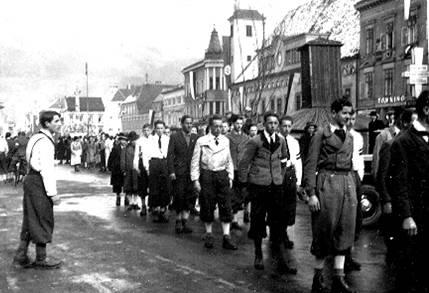
Poldi with his Hitlerjugend on main square, Leoben
The Town Hall of Leoben - calm before the storm
20 February 1938: Today is Sunday. We find out that the telephone offices are overloaded with calls. In the city all is still quiet. More or less. Towards noon the rumor appears: torchlight evening! I inquire if it's true. Yes, it is. At lunch there are already swastika flags in some windows. Everything is very excited, but in the city there is strange calm. Right after lunch I get the final command from our unit: "6 o'clock torchlight parade. The HJ gather at the corner Langgasse-Josef Grafgasse! Bring banners!"
I quickly send the messengers. Everything goes like clockwork. That reminds me of Ebert - naturally they will not come back until after dark. But that would be too late. Guenther Böhm was in the camp already this morning; now he goes again by bicycle, which he had adorned with a swastika pennant, to the Schladnitzgraben.
Meanwhile the city came alive. All have heard the Führer on the radio talking in the Reichstag. Everyone is delighted. On the streets you can see boys and men running. Everything is moving. Guenther Böhm is already back. He informs me that Ebert with the boys are already marching back. During the whole of Sunday they had the swastika flag hoisted. At 5 o'clock Ebert has still not arrived, so I'm going to meet him. I meet all the camaraderie behind Gör. One has the swastika flag on a ski stick as they ride down the mountain on skis towards me.
When we came back to the city, even the whole square was full of expectant people. Many brought the torches. Before dusk it's impossible to procure a torch. Then it was 6 o'clock. All the streets were full of people, not a policeman to be seen far and wide. We gathered in the Langgasse, the HJ from Donawitz were already there. Not one was missing of my flock, all 30 boys, some barely 14 years old. Also a long column of BDM [Bund Deutsche Mädel] girls were ready. Then the order was given: The leaders march in the middle of their unit so the orders will come from the middle, not from the front. Then we got the torches and it started.
As we reached near the main square, the vortex formed there. In Timmerdorfergasse we got stuck and had to wait to join the endless columns of marching units of the SS, SA, PO, civilians and the Women's League.
Behind us marched BDM and Jungvolk, then the SA units with their old storm flags, the sight of which made our hearts beat faster. We marched and sang and cheered through the main square, in the direction to Donawitz. The streets were lined with mostly women and soldiers who cheered us so much that it is impossible to describe.

In front of the Waasenbrücke (railway bridge) in Leoben [this picture taken at the time of the April 10 plebiscite].
At the Waasenbrücke we saw a policeman on duty. We called at him, but he did not move. Then we passed the Jewish shops. There we sang the Song of the Storm Soldier (Lied vom Sturmsoldaten) and shouted "Judas perish! Heil Hitler! Who is our leader? Adolf Hitler" and so on until we were hoarse and could shout no more. In Donawitz I saw some of our high school professors shouting “Heil Hitler;” it was a joy. Then we marched back to Leoben, this time the HJ (Hitler Jugend) and DJ (Das Jugendvolk) alone. At the barracks we stopped, we approached the front of the barracks and sang. "In the East, a new day has begun to glow ... We are sons of the Ostmark, our country, the beautiful, our struggle and the victory!" The soldiers opened the windows, but they dared not sing with us yet.
Then we marched to the floodplains on the Jahn-meadow, formed a large, open square, on one side of which all the flags were displayed. Then the leaders inspected their units because during the march many boys whom we didn't know joined us. Then Unterbannführer Ebner made a report. It was the most beautiful ceremony I had ever seen. Ebner spoke to us of the importance of this moment and that our fight was not yet over, but that we only now were entering the decisive phase in the history of Ostmark, and called us again to prepare ourselves for the decisive battle. With Deutschlands and Horst-Wessel-Lied and the Song of the Youth the celebration came to an end. Then we were handed over the flags for safekeeping. These were a little small for our current criteria, but for us they were a symbol. Through deserted streets, late in the night, we went home. An eventful, beautiful day was over.
21 February 1938: When I came to school, people were greeting everywhere with the Nazi salute. Prof. Schröckenfuchs could not teach, but ran around in the classroom and ordered us to read aloud from the book "3 times Austria."
I later learned that in Kallwang he got a spanking from the local Hitler Youth under the leadership of Kaiblinger as he tried to provoke with the VF (Patriotic Front). In the afternoon I learned that in Trofaiach a torchlight march was to start and on this occasion a whole unit of SA (Unit 13) was marching there. I told this to the unit leader Marek and made the proposal that HJ go to Trofaiach on bicycles. That's what we did. Everybody who had time agreed and off we went.
Meantime my flag got a nice pointed end with swastika of sparkling brass. This item was crafted in the afternoon in dad's workshop by the workers; everyone was feeling the enthusiasm. Wherever we passed we were greeted by the residents.
Just before Troiafach we passed the 13th SA Unit, whose men also welcomed us warmly and enthusiastically. There we dismounted the bicycles and joined the Hitler Youth from Donawitz. We marched together in Trofaiach and then began a torchlight procession. Along the roadside there were hardly any people, for the entire population marched with us. On the main square there was a speech and then we rode back home. We had flags on our bikes. As we walked in the Donawitzerstraße, a few Communists taunted us, but when we stopped they quickly disappeared. Late in the evening I came home dead tired.
22 February 1938: In the morning at the school we were told that we were forbidden to salute with the Hitler salute, to shout Sieg Heil or to wear the swastika. But we cared very little about these bans. We not only wore these badges, but we made them ourselves. We already had great practice in it. We gathered five penny pieces, wherever we could find them; we honed them square, polished and sawed with a hacksaw the contours of the swastika. A pin was bent into shape and soldered on, and the badge was ready. I then let them sell through my boys so we got a bit of money for our common fund. At 8 o'clock in the evening was a planned Führer roll call at Seidler Emil's apartment. At 7 o'clock in the main square began a strolling demonstration against Schröckenfuchs, Gorbach, Pichler etc. Large posters read: "Down with the German-haters Schrockenfuchs, etc." I had left the demonstration earlier to go to the roll call. Here we got new guidelines from the Unterbannführer Ebner and the liaison to the division in Graz, Seidler. A members barrier for the HJ was imposed and only HJ aspirant groups could be formed. In view of the perilous times, we were allowed to carry weapons (only the leaders). 

Above: Marek leads the Hitler Jugend past the Grand Hotel and along the street.
23 February 1938: At noon Gefolgschaftsführer Marek called me to his apartment. He handed me a heavy Walther automatic pistol (9 shots) and 90 rounds of ammunition. Then he told me about the gun and its use. For the evening he scheduled two Horst Wessel celebrations: the first at 6 o'clock for 15 younger comrades and the second celebration should start at 8 o'clock. For this purpose we had guarded all roads during the entire ceremony (The celebrations took place in the woods above the hunting house) – so we were protected from any insidious attack as had indeed occurred repeatedly. Both celebrations were well prepared and were not without effect on the boys. I spoke briefly about the life and death of our freedom heroes and I ended with a call to emulate our models. All were enthusiastic and sang the song of our dead heroes.
24 February 1938: At 8 o'clock in the evening a Führers' roll call at Günther Böhm. At the same time Schuschnigg begins to speak from Innsbruck. When I get home, I hear Schuschnigg call: "Men - it's time!" We are to vote, and that on the13th of March – we are all greatly outraged.
25 February 1938: Our dear VF took the speech of Schuschnigg as the occasion to hold a rally at the main square. Leoben has always been a hot spot, so the police from the whole of Upper Styria came to the town and were billeted in the youth center (Major Fey home) in Gaswerksstraße. If you went onto the street, every fifty meters you met police sentries with fixed bayonets and helmets. Then, in the evening the Fatherland Front (VF) marched. In the early afternoon, the main square was cordoned off. The HJ had opened its first office in “paradise hall” of the Hotel Post. The entire hotel was the headquarters of the party, district leadership, SA Brigade, SA Standarte – it was all here together. In the corridors, SA men in uniform stood on guard. During the day there was already high tension in Leoben and everyone felt that today it might be discharged.
And that's what happened. From all over the Upper Styria our SA had gathered here and already before dark the main square was completely filled by the Nazis before the half (in front of the City Hall) was cleared by the police and cordoned off. Then began the parade of VF or rather of organized KP [Communist Party]. The result was that half the square was filled with VF, the other with our people. In between were the gendarmes. Then some HJ leaders, including myself, got an order to look for a car with a certain registration number. We have been told that it would have a machine gun installed in a headlight. We got a lot of other reconnaissance. In the meantime, the whole HJ of Leoben and HJ Donawitz led by Toni Bauerfeind had placed themselves between the marching columns of VF, shouting "Heil Schuschnigg." No sooner than they were among the blacks, they started to sing, unfurl the swastika banners and their shouts changed. It became clear that these boys had a tough time with the black-red band – torches were thrown in their face, women beat them with chains. They were insulted and spat upon with wild shouts. The black-reds wanted to snatch their flag, but Bauerfeind himself held it firmly in his hand. He dealt a couple of hits so that no one dared to touch it. This went on until the rally was over and the national anthem was played. Of course, all sang the Deutschlandslied and instead of the VF-youth song (your boys close the ranks well …), the Horst Wessel song.
Crowds are filling the main square
However, the HJ was hit hard. Some were beaten and wounded. They had been hit in the head with chains or kicked in the abdomen. Two, Richter and Milchrahm, our inspection service dragged from the inn "Vienna" where they were put temporarily, through the main square to the Hotel Post. We then had to make patrols throughout the city, armed with a pistol, until 2 o'clock in the morning.
26 February 1938: In the morning there was of course school, in the afternoon I marched with a few boys in my troop to our cabin in Schladnitzgraben to prepare everything for the big downhill run and the patrol run. Evening, Gefolgschaftsführer Marek came to us. It was a fine evening, except the oven was smoking heavily.
27 February 1938: The day began as usual with morning exercise, etc. Then all participants arrived successively. My troop was almost complete (with 16 men). Maschek was represented by only 6 and Göß (Geisendörfer) was completely absent. The day passed with downhill skiing and patrol run where my troop took the first places everywhere. For that we were awarded the first HJ-flag.
28 February 1938: Start of the ski week in Leobner Gymnasium. I am the ski instructor in the 2nd Class.
1 March 1938: morning ski lessons in the lowlands. 20 o'clock roll call of camaraderie (Günther Böhm).
2 March 1938: Morning the ski course on Massenburg, 17 o'clock roll call of camaraderie 2 (Sepp Ebert) in our apartment. 20 o'clock roll call of camaraderie (Blasl Bertl) in his room at Liftl.
3 March 1938: Because of rainfall the ski course was called off. 20 o'clock and 20 o'clock 30 two appeals by two camaraderies.
4 March 1938: We got a stack of Führer pictures from Graz and sold them all. I alerted my troop and in the afternoon almost all the pictures were sold. Although this was forbidden by the police.
5 March 1938: New pictures had to be sold. Since Unterbannführer Ebner had to leave for a camp, I had to conduct the entire sale for Leoben. Shortly before, the Hotel Post had a house search - but here they found nothing.
6 March 1938: 3 o'clock afternoon a roll call. Over the week, I had 10 roll calls.
History Professor Peintinger speaks to us on the Massenburg
Above: Ceremony held at the Massenburg in Leoben by the Hitler Jugend, in March 1938
Girl's unit of the Hitler Youth, Bund Deutscher Mädel, participate too.
8 March 1938: In the evening I held a Führer roll call. On the way home I heard screams, "One, two, three! Down with Hitlerism", "red-white-red, Hitler dead", etc. VF [Vaterlaendische Front - Schuschnigg's Party] wanted to demonstrate. Gendarmerie stood in front of the Hotel Post. In a moment, everybody was out of the hotel. The policemen wanted to reassure us and said "do not provoke, let the KP [Komunistische Partei] scream all they want!" I made an astonished expression and asked where were the KP. The policeman pointed to the VF and replied: "That is no different than the organized KP." The other policeman agreed with him. Obviously, this is a new inspiration for the raging storm troopers around. And as the Blacks [the clerical party linked to the Catholic Church] were screaming on, the fight began. In Krottendorfergasse they were attacked from two sides and beaten so long that the SA Brigade Commander, Wolf Bauer, came running and gave the order to stop. The Blacks felt lucky to be able to break away with bleeding skulls.
11 March 1938:[Leoben] Trucks continuously drove through the city and dropped leaflets: "Vote for Schuschnigg," etc. But as soon as they lay on the ground, the HJ [Hitler Jugend] picked up the papers and threw them in the river Mur. This lasted all day. Also aircraft threw off leaflets and everybody was in a boundless rage. To make matters worse, the people's militia was armed, marched out and by 3 o'clock afternoon all public buildings (post office, train station, district court, etc.) were occupied by these scoundrels. But their dream did not last long. By 5 o'clock I met Mr. Ebner of the DAF [Deutsche Arbeiter Front] who called out to me: "The vote is postponed, tell everybody to fly flags at all houses."
That was good news! I ran straight to the HJ office, which was in Vorderbergerstraße for some time. Here I was ordered: "Tonight a great torchlight procession, venue Josef Grafengasse. Alert everybody!” And then it started. The whole square was full of people. We all got the “rubber sausages“ - just in case. The first time we went with our troop flag. We marched with lighted torches on the main square in front of the Town Hall to the rally. The whole place was full. Under the Town Hall balcony [Austrian] SS stood with helmets and flags. All around stood gendarmerie with bayonets.
Then, from the balcony spoke the chief of staff of the SA Brigade, Steindl. As he shouted down, "German troops have crossed the border and stand in Austria," everywhere sounded a joy, as you can hear it only once. Then he set all our opponents free to leave the city immediately and insisted that no blood should be shed. Afterwards the illegal Kreisleiter Kristandl spoke. Then the columns marched towards Donawitz by where the cinema was (...)
As we were being dismissed, we still had to attend the Führer roll call where we received guidelines for the next days. Then, we strongly believed that in the course of the night the German troops would march into Leoben and we did not want to miss the occasion.
Even as the rally in the main square was going on, all gendarmes suddenly disappeared from the police station and when they came back again, they all had SS armbands. We could not believe it at first, and it seemed almost like living in a dream. Of course no troops could come so quickly. At this time they were not even in Salzburg, but I had really no desire to go to sleep. It started to rain and the crowds disappeared from the streets. I saw how the SA was being armed with the guns of the People's Militia. [PM was a Schuschnigg organization.] I was there at 1 o'clock [a.m.] as the House of VF, the Chamber of Labour, was occupied. By 3 o'clock in the morning Lieutenant Vinek got a swastika flag from Hotel Post and let her fly over the barracks. Only then I went to sleep.
12 March 1938: The home of the Austrian Jungvolk was occupied by the gendarmerie. It belonged to us. By 14 o'clock [2 pm] we occupied it, stuck up a sign that Dad had painted, NSDAP - HITLER JUGEND, and treated the police as our guests. In the evening we were called away from a meeting in order to requisition cars of known anti-Nazis. Massenburg was occupied by HJ.
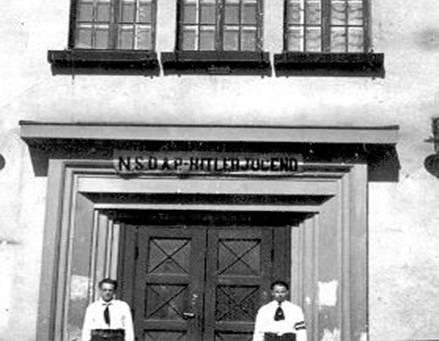
First Hitler Jugend home in Leoben
13 March 1938: In the afternoon all our followers marched to Tollinggraben where the big Jungvolk home was. It was occupied and I had to stay up with 5 men. Towards the evening an order came by the telephone that we should immediately come to Leoben, as we should be then moved to Graz; the Führer was in Graz, it said. When we were leaving, I could not help but to shoot a series at the big board of the home with my revolver.
In Leoben, we were loaded onto trucks the side planks of which almost burst. It was freezing cold. Of course the Führer was not in Graz. So we went back again. Since most were wearing only shirt and skirt, the girls who rode in buses loaned us their coats. Nevertheless, it was almost unbearable. At midnight, we arrived in Leoben and then we had night duty. During sentry duty the gendarmes loaned us their coats and helmets.
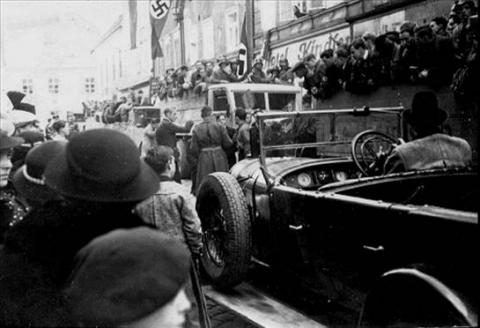
Ready to go to Graz

Enthusiastic departure for a rally in Graz which never took place
14 March 1938: The garrison troops were sworn in [to] the Führer. The first German police come to Leoben. In the morning my Dad led me to Bruck on the Mur. There, already the German military had come from Vienna.
German police troops welcomed by the population
German police seen in Leoben after March 13
 German (left) and Austrian police officers,now with swastika armbands, greet cordially
German (left) and Austrian police officers,now with swastika armbands, greet cordially
15 March 1938: Wieder and I had guard duty. Throughout the night.
16 March 1938: The service became more regular
17 March 1938: We needed uniforms, but we never could find them. In Bruck we got two brownshirts. Everything else was sold out. On the castle square at the Massenburg there was a brief celebration of the school under the new director Prof. Peintinger.
18 March 1938: the Bannführer of Styria was visiting Leoben.
20 March 1938: Finally the first German troops, already expected so much by the whole population, came to Leoben.
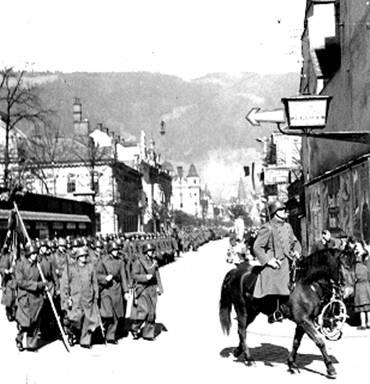 Above: The Federal army marches on the main square, Leoben
Above: The Federal army marches on the main square, Leoben

